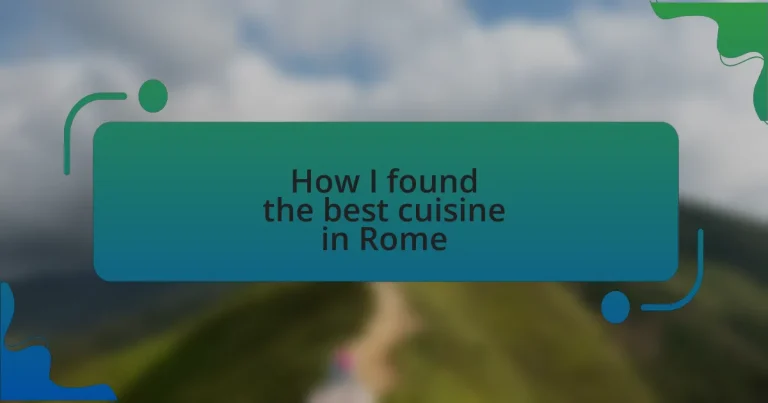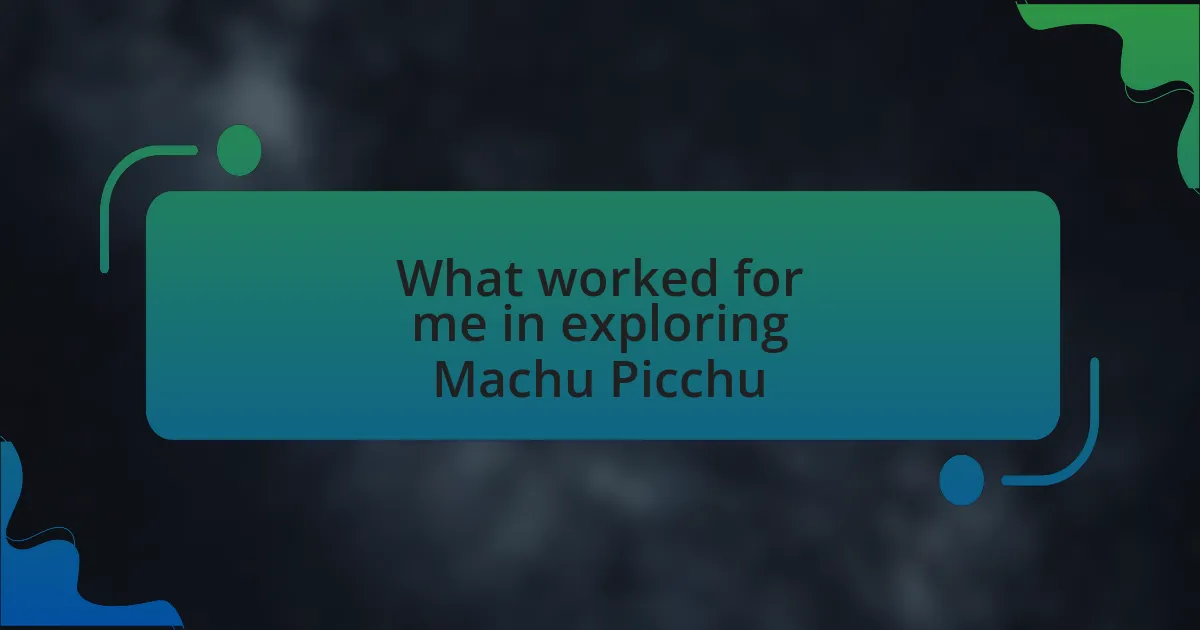Key takeaways:
- Evelyn Hartley emphasizes that travel blogging connects readers through shared experiences, highlighting the emotional significance of local cuisine.
- She shares personal anecdotes about dining in Rome, illustrating how food reflects culture and fosters connections among people.
- Planning and seeking local recommendations enhance culinary adventures, leading to hidden gems not found in tourist guides.
- Dining experiences in Rome can evoke deep emotions and create unforgettable memories, showcasing the magic of food and community.
Author: Evelyn Hartley
Bio: Evelyn Hartley is a bestselling author known for her compelling historical novels that delve into the complexities of human relationships. With a background in literature and a passion for storytelling, she crafts richly detailed narratives that transport readers to different eras. Her award-winning debut novel, “Whispers of the Past,” was praised for its vivid characters and intricate plots. When she’s not writing, Evelyn enjoys exploring antique shops and researching the fascinating stories behind forgotten artifacts. She resides in a charming cottage in Vermont, where she draws inspiration from the beauty of nature and the stories it holds.
Understanding travel blogging
Travel blogging is more than just sharing photos and stories; it’s about connecting with readers through shared experiences. I remember my first trip to Italy—every bite of pasta seemed to tell its own story, inviting me to delve deeper. Have you ever tasted a dish so remarkable that it made you rethink your palate?
What makes travel blogging truly powerful is the ability to convey emotions and insights from our journeys. When I stumbled upon a cozy trattoria in Rome, the warmth of the place and its people wrapped around me like a favorite blanket. That emotional connection is something I strive to capture in my writing, inviting readers to feel as if they’ve experienced it themselves.
In essence, travel blogging is a quest for authenticity. Each destination offers a myriad of experiences, and it’s up to us as writers to explore those intricacies. Don’t you think it’s fascinating how a simple meal can encapsulate the essence of a culture? Through my travels, I’ve learned that these moments are what truly resonate with readers.
Importance of local cuisine
Exploring local cuisine is like opening a treasure chest filled with the culture and traditions of a place. I remember savoring a dish of cacio e pepe in a small Roman eatery, where the simplicity of pasta and cheese revealed the culinary artistry that defines Italian cooking. Isn’t it amazing how food can tell us where we are and the stories behind its recipes?
Local cuisine serves as a bridge between the past and the present, allowing us to taste history. During one of my visits, I encountered a chef who shared his grandmother’s secret tomato sauce recipe, passed down through generations. That moment showed me that every bite carries a legacy; isn’t it intriguing to think about the countless memories tied to one dish?
Understanding the importance of local cuisine also enhances our appreciation for the people we meet along the way. One evening, as I dined with a family in Rome, I realized that sharing a meal goes beyond satisfying hunger—it’s about forging connections. Have you ever felt that sense of belonging while enjoying a local dish? It’s experiences like these that stay with you long after the tables are cleared.
Planning your culinary journey
When I set out to explore Rome’s culinary scene, I quickly learned that planning is key. I often spend evenings digging through local blogs and food guides to map out eateries famous for specialties like supplì or Roman-style pizza. Have you ever noticed how a little research can turn a simple meal into a gastronomic adventure?
Timing your visits can make all the difference too. I remember walking into a bustling trattoria just as they were pulling out trays of freshly made gnocchi; the aroma was transformative. It hit me then: dining at the right time not only ensures you taste the freshest food but also allows you to soak in the lively atmosphere of the city. Isn’t it fascinating how ambiance enhances our culinary experience?
A helpful tip I’ve adopted is to ask locals for their favorite dining spots. On my last trip, a barista at my favorite café recommended a hidden gem tucked away in a side street. I followed their advice and discovered wondrous dishes that weren’t on any tourist radar. Isn’t it incredible how the best culinary experiences often come from those who know the city best?
Exploring Rome’s food culture
Exploring Rome’s food culture is like diving into a vibrant tapestry woven with history and tradition. One of my fondest memories is enjoying a steaming bowl of cacio e pepe at a quaint eatery near the Colosseum. As I savored each bite of the creamy pasta, I couldn’t help but wonder how this simple dish, crafted from just cheese and pepper, could evoke such deep-rooted stories. Have you ever tasted a meal that felt like a piece of history?
The charm of Rome doesn’t just lie in its iconic landmarks; it also resides in its bustling markets. I remember strolling through the Campo de’ Fiori, where the colorful stalls overflowed with fresh produce and local delicacies. The vibrant conversations among vendors and shoppers painted a picture of community life centered around food, reminding me that every meal shared is a celebration. Isn’t it remarkable how food brings people together, transcending language and culture?
Dining in Rome can be an adventure in itself. I once found myself at a family-run trattoria, where the nonna, or grandmother, was busy preparing traditional dishes while sharing stories of her family’s recipes. Surrounded by laughter and the aroma of garlic and herbs, I felt an emotional connection to the essence of Roman cuisine. How often do we get a chance to taste the legacy of a family crafted with love?
Tips for finding hidden gems
When exploring for hidden gems in Rome, I suggest wandering away from the main tourist paths. One afternoon, I discovered a tiny osteria tucked in a narrow alley near Trastevere. It felt like stepping into a local’s living room, complete with mismatched furniture and friendly chatter. Have you ever experienced a place that feels like a secret only you know about?
Don’t hesitate to engage with locals. I remember chatting with a barista while sipping an espresso in a bustling neighborhood café. She shared her favorite spots, leading me to an unexpected pizzeria that served the most incredible white pizza I’ve ever tasted. Isn’t it amazing how a simple conversation can unlock an entire world of culinary delights?
Lastly, embrace spontaneity. One evening, I took a wrong turn on my way to dinner and ended up at a festival celebrating local food. The joyful atmosphere and homemade delicacies introduced me to flavors I didn’t know I was missing. How often do we stumble upon the best experiences when we least expect them?
My personal Rome dining experiences
There’s something magical about dining in Rome that I never quite expected. One evening, I found myself in a small trattoria in the heart of a charming neighborhood, where the aroma of garlic and fresh basil enveloped me like a warm hug. As I savored each bite of handmade pasta drizzled with the finest olive oil, I couldn’t help but wonder: how does something so simple evoke such deep joy?
I still remember the night I visited a family-run ristorante where the owner insisted I try his grandmother’s secret recipe for gnocchi. They were fluffy clouds of goodness, paired with a rich tomato sauce that burst with flavor. That meal, under twinkling lights with laughter all around, made me think: is there anything better than sharing a table with strangers who quickly feel like friends?
On a rainy afternoon, I ducked into a cozy café seeking refuge and discovered the most delightful arancini. These little rice balls, crispy on the outside and oozing with cheese on the inside, were a revelation. I often reflect on how those spontaneous decisions can unveil treasures—what hidden flavors await you in an unexpected corner of the city?
Recommendations for the best restaurants
Finding the best restaurants in Rome is a delightful adventure in itself. For instance, I stumbled upon a rustic pizzeria tucked away from the main tourist paths. As I bit into the thin, charred crust adorned with fresh mozzarella and vibrant basil, I couldn’t help but think, is there magic in a bite that transports you to another world? That slice was a perfect reminder that sometimes the best meals are found where you least expect them.
On another occasion, I wandered into a bustling market where I encountered a food stall serving authentic supplì. These crispy rice croquettes filled with gooey mozzarella were simply life-changing. I can still feel the excitement of biting into one, feeling the creamy cheese stretch as if it were giving me a warm embrace. It begs the question: what other simple yet profound culinary secrets lie waiting at the stalls of Roman markets?
For a truly unique experience, I recommend dining at a ristorante that offers cooking classes. During my visit, I was captivated not only by the food but also by the stories shared by the chef who taught us to make cacio e pepe. There’s something remarkable about cooking with locals—each bite of that creamy, peppery pasta not only satisfied my hunger but also filled my heart with a sense of belonging. Isn’t it fascinating how food can bridge cultures and create connections?



